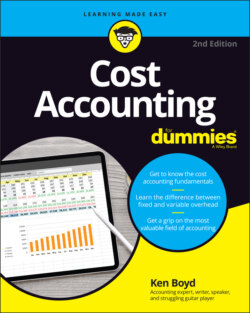Читать книгу Cost Accounting For Dummies - Kenneth W. Boyd - Страница 39
Fitting the costs together
ОглавлениеThis section explains how direct costs, indirect costs, fixed costs, and variable costs all fit together. One simple way to explain the relationship is to go over some examples. Table 2-2 shows you an example of four types of costs.
TABLE 2-2: Fixed and Variable Costs, Direct and Indirect Costs — Examples
| Direct Cost | Indirect Cost | |
|---|---|---|
| Fixed costs | Hourly union wages | Equipment lease |
| Variable costs | Material and labor cost | Factory utility costs |
Table 2-2 is a new territory. Each cost can be classified as either direct or indirect and either fixed or variable. Let’s go through the examples one at a time.
Say you manage a factory. You pay wages to hourly workers based on a union contract. The contract states the number of hours each employee works and their pay rate per hour. The total wages paid is a fixed cost. The cost is also a direct cost. That’s because the only reason to have hourly workers is because you’re producing a product. No production, no hourly workers — and no cost.
In the section “Kicking around fixed costs,” you work with an equipment lease. Because the equipment is used to make a product, the lease is a fixed, indirect cost. You allocate the indirect cost based on the number of units (desks) created.
Material and direct labor costs are addressed in the section “Comparing direct and indirect costs.” Those are variable costs that change (in total) with your level of production.
If you manage a factory, you incur utility costs to heat, cool, and provide power to the factory. The more products you produce, the more utility costs you incur. So utility costs can vary with the level of activity.
Utility costs are also indirect costs. Because you can’t trace the costs directly to a product, you have to allocate them. Utility costs are often allocated using labor hours for a particular time period.
